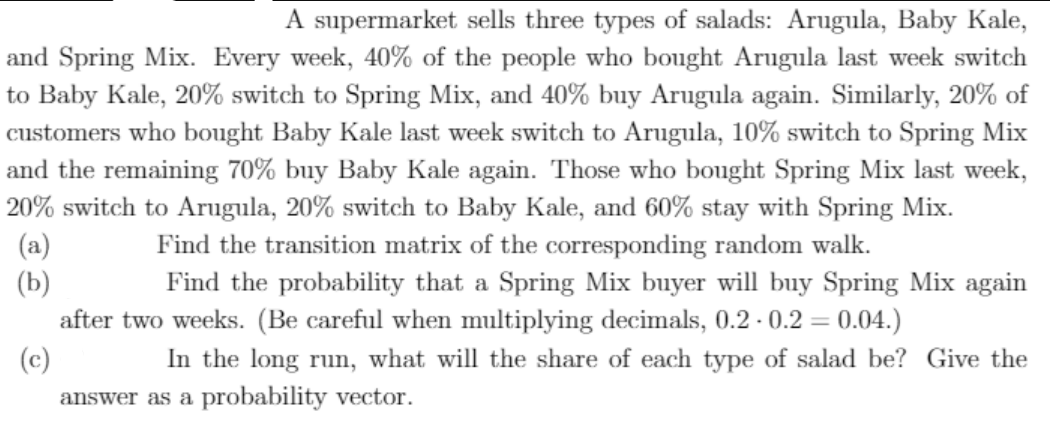A supermarket sells three types of salads: Arugula, Baby Kale, and Spring Mix. Every week, 40% of the people who bought Arugula last week switch to Baby Kale, 20% switch to Spring Mix, and 40% buy Arugula again. Similarly, 20% of customers who bought Baby Kale last week switch to Arugula, 10% switch to Spring Mix and the remaining 70% buy Baby Kale again. Those who bought Spring Mix last week, 20% switch to Arugula, 20% switch to Baby Kale, and 60% stay with Spring Mix. (a) (b) after two weeks. (Be careful when multiplying decimals, 0.2 - 0.2 = 0.04.) (c) Find the transition matrix of the corresponding random walk. Find the probability that a Spring Mix buyer will buy Spring Mix again In the long run, what will the share of each type of salad be? Give the answer as a probability vector.
A supermarket sells three types of salads: Arugula, Baby Kale, and Spring Mix. Every week, 40% of the people who bought Arugula last week switch to Baby Kale, 20% switch to Spring Mix, and 40% buy Arugula again. Similarly, 20% of customers who bought Baby Kale last week switch to Arugula, 10% switch to Spring Mix and the remaining 70% buy Baby Kale again. Those who bought Spring Mix last week, 20% switch to Arugula, 20% switch to Baby Kale, and 60% stay with Spring Mix. (a) (b) after two weeks. (Be careful when multiplying decimals, 0.2 - 0.2 = 0.04.) (c) Find the transition matrix of the corresponding random walk. Find the probability that a Spring Mix buyer will buy Spring Mix again In the long run, what will the share of each type of salad be? Give the answer as a probability vector.
Linear Algebra: A Modern Introduction
4th Edition
ISBN:9781285463247
Author:David Poole
Publisher:David Poole
Chapter2: Systems Of Linear Equations
Section2.4: Applications
Problem 3EQ: A florist offers three sizes of flower arrangements containing roses, daisies, and chrysanthemums....
Related questions
Topic Video
Question
Please help me

Transcribed Image Text:A supermarket sells three types of salads: Arugula, Baby Kale,
and Spring Mix. Every week, 40% of the people who bought Arugula last week switch
to Baby Kale, 20% switch to Spring Mix, and 40% buy Arugula again. Similarly, 20% of
customers who bought Baby Kale last week switch to Arugula, 10% switch to Spring Mix
and the remaining 70% buy Baby Kale again. Those who bought Spring Mix last week,
20% switch to Arugula, 20% switch to Baby Kale, and 60% stay with Spring Mix.
(a)
(Б)
after two weeks. (Be careful when multiplying decimals, 0.2 - 0.2 = 0.04.)
(c)
Find the transition matrix of the corresponding random walk.
Find the probability that a Spring Mix buyer will buy Spring Mix again
In the long run, what will the share of each type of salad be? Give the
answer as a probability vector.
Expert Solution
This question has been solved!
Explore an expertly crafted, step-by-step solution for a thorough understanding of key concepts.
Step by step
Solved in 4 steps with 3 images

Knowledge Booster
Learn more about
Need a deep-dive on the concept behind this application? Look no further. Learn more about this topic, advanced-math and related others by exploring similar questions and additional content below.Recommended textbooks for you

Linear Algebra: A Modern Introduction
Algebra
ISBN:
9781285463247
Author:
David Poole
Publisher:
Cengage Learning

College Algebra
Algebra
ISBN:
9781305115545
Author:
James Stewart, Lothar Redlin, Saleem Watson
Publisher:
Cengage Learning

Algebra and Trigonometry (MindTap Course List)
Algebra
ISBN:
9781305071742
Author:
James Stewart, Lothar Redlin, Saleem Watson
Publisher:
Cengage Learning

Linear Algebra: A Modern Introduction
Algebra
ISBN:
9781285463247
Author:
David Poole
Publisher:
Cengage Learning

College Algebra
Algebra
ISBN:
9781305115545
Author:
James Stewart, Lothar Redlin, Saleem Watson
Publisher:
Cengage Learning

Algebra and Trigonometry (MindTap Course List)
Algebra
ISBN:
9781305071742
Author:
James Stewart, Lothar Redlin, Saleem Watson
Publisher:
Cengage Learning